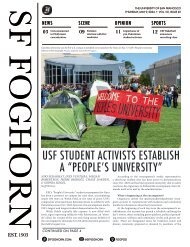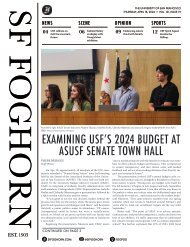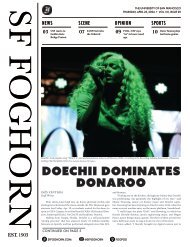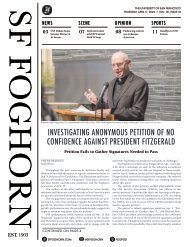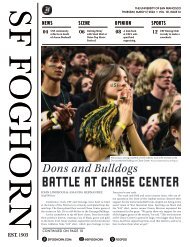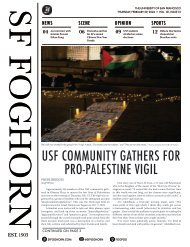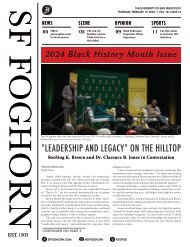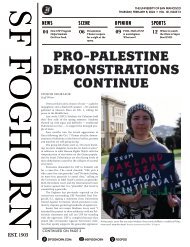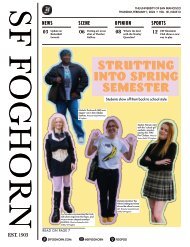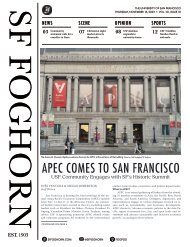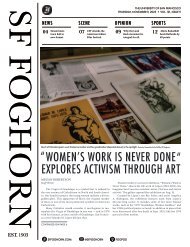VOL 119, Issue 7—Oct. 28, 2021
You also want an ePaper? Increase the reach of your titles
YUMPU automatically turns print PDFs into web optimized ePapers that Google loves.
10<br />
THURSDAY<br />
OCT. <strong>28</strong>,<br />
<strong>2021</strong><br />
LETTER TO THE EDITOR:<br />
CAMPUS CULTURE REPRESENTED IN OUR MASCOT<br />
DONS WEEKLY<br />
ROUNDUP<br />
11<br />
OPINION<br />
Dear USF Foghorn and members of our USF Community,<br />
As a content warning, the following letter includes reference to recent events<br />
and coverage of sexual assault and harassment on campus. I thank the Foghorn<br />
for their reporting and the many students who have contributed to the recent<br />
coverage in the interest of creating a better USF.<br />
When the Sports Illustrated article “A Predatory Culture, a Viral Reckoning—and<br />
Now What?” broke, my phone—like those of so many in the USF<br />
Community—lit up with messages as the story spread across social media and<br />
local news outlets. When I sat down to read the full article I felt a range of emotions.<br />
In some regards, nothing surprised me; there was nothing necessarily new<br />
in the article, which compiled together years of stories and evidence into one expanded<br />
and very public story. As I read the powerful testimonies of numerous students<br />
reporting incidents only to then be ignored, I couldn’t help but think of all<br />
of the stories this article did not mention. As a female faculty member at USF for<br />
the past 12 years, I’ve witnessed<br />
numerous students struggle with<br />
reporting sexual assault, sexual<br />
harassment, and other inappropriate<br />
behavior only to experience<br />
the same tepid responses<br />
and lack of resolution outlined<br />
in the recent article.<br />
I applaud Lili Makensie’s<br />
recent op-ed in the Foghorn<br />
that expands the conversation<br />
of survivors to include other<br />
gender identities and traumatic<br />
situations. In addition to the<br />
female-identifiying students<br />
whose stories I’ve heard, and<br />
whom I assisted with reporting<br />
and providing crisis resources,<br />
I’ve also had queer male-identifying<br />
students share stories of<br />
being assulted and harassed as<br />
well. As Makensie points out,<br />
the issue goes beyond the soccer<br />
team, beyond cis-gender female-identifying<br />
students, and<br />
even beyond students.<br />
I too, as a faculty member, have experienced inappropriate harassment on<br />
campus. These issues, of course, extend far beyond USF and are rooted in patriarchal<br />
systems of oppression in our larger culture. These systems continue in part<br />
because of prevalent stereotypes, including that of our own “Don.”<br />
One of the main problems the recent Sports Illustrated article highlights is<br />
that the third-party investigation found “the number of sexual misconduct incidents<br />
within the men’s soccer program over a decade does not represent a pervasive<br />
culture.” I’m left asking then, if it’s not “a pervasive culture,” what kind of culture<br />
does it represent? And what kind of culture does USF as a whole represent?<br />
In a recent meeting, the USFFA (the full-time faculty union at USF) had<br />
with our new Provost Chinyere Oparah, she called for a cultural reset.<br />
After the many tragedies, mishaps, frustrations, pandemics, and issues USF<br />
has experienced in the past several years, I couldn’t agree more. I truly appreciate<br />
the many listening sessions Provost Oparah has had to listen to the voices of the<br />
USF community beyond those in administration. I am eager to work with her<br />
and with others to co-design a new USF. To help precipitate this cultural reset<br />
then, I cannot help but call out a need to examine the USF mascot.<br />
The Don, according to the USF website, was “once used as a fancy way to<br />
address Spanish nobles,” and has evolved to mean “a distinguished gentleman.<br />
You know the type.” But I’m not sure: do I know the type? Many other common<br />
GRAPHIC BY JAMES SALAZAR/SAN FRANCISCO FOGHORN<br />
definitions refer to a Don as a leader of an organized crime family. The Urban<br />
Dictionary refers to a Don as “a man who is very sexy and powerful. This man<br />
can control the hearts of all women, while being caring and still sexy.” Beyond the<br />
inherent sexism in this image, I also have questions about the use of this "highly<br />
stylized version of an old-school Spanish look” as mascot.<br />
As a Design Professor who teaches visual communication and idenitity, I<br />
can’t help but see the connection between a masked male mascot—known for<br />
controlling women, organized crime, Spanish colonization, unapologetically lassoing<br />
and sword fighting, and riding off on his high horse—and the culture that<br />
has allowed the many accounts of chauvinistic behavior, sexual harassment and<br />
assult to occur at USF. The images and symbols we choose to surround ourselves<br />
with have an impact on how we perceive ourselves, and in the case of schools, can<br />
affect students' self-esteem and overall climate.<br />
In the summer of 2020, in the midst of the racial reckoning in the U.S. that<br />
followed the murder of Geroge Floyd, many corporations took up re-branding<br />
inativies to reassess their image. Aunt Jemima, Uncle Ben’s, Eskimo Pies, Land<br />
O’Lakes, Mrs. Butterworth’s, and many more brands took on new more inclusive<br />
identities. Many pro sports<br />
teams also began renaming and<br />
rebranding initiatives including<br />
the Washington Football Team,<br />
the Cleveland Indians, and Kansas<br />
City Chiefs. Many colleges<br />
have also changed mascots for a<br />
variety of reasons.<br />
In some of my classes, I teach<br />
about how we communicate with<br />
images, colors, symbols and words<br />
in visual literacy. I’ve presented<br />
many of these branding case studies<br />
to students and analyzed what<br />
is being represented, to whom,<br />
by whom, and how. I tell my students<br />
that as designers, we do not<br />
just make pretty pictures. There is<br />
inherent meaning behind whatever<br />
we create, and it is our job as<br />
designers to be sensitive to what<br />
we communicate and how. What<br />
does it mean that we put masks<br />
and mustaches on people in our<br />
community?<br />
The images and symbols we choose to surround ourselves with and represent<br />
ourselves with have an impact on our collective well-being. I know that many<br />
other students, faculty, and staff agree that a university which defines itself by its<br />
social justice mission should not be represented by a Don.<br />
I am not suggesting that simply changing our mascot will magically make<br />
the sexist and traumatic experiences on campus go away. There’s a lot of work to<br />
be done. I understand and support the students' demands for an apology from<br />
the administration and to take accountability for the harm that has been caused<br />
not only for those named and recognized in the case against the men's soccer<br />
team, but for all of the incidents that have occured at USF and in support of all<br />
survivors in our community.<br />
As we move forward in what I hope will be a true cultural reset, in what I<br />
hope will be an open dialogue on campus about supporting survivors and inclusive<br />
intersectional change on campus, we need to ask: what kind of culture do we<br />
represent? And what might that culture look like in a mascot? When we cheer on<br />
not only our sports teams, but our entire USF community, I’d like to cheer for a<br />
mascot that represents an inclusive, progressive community.<br />
Rachel Beth Egenhoefer<br />
Professor, Design, USF<br />
Freshman Elle Soleau dribbles before sending a pass. PHOTO COURTESY OF CHRIS M. LEUNG/DONS ATHLETICS<br />
JASON TITUS<br />
Contributing Writer<br />
USF soccer had a strong week on the pitch<br />
as the men’s and women’s teams came away with<br />
wins in their respective matches. Elsewhere,<br />
USF women’s volleyball could not put a stop to<br />
their losing skid. Here is your recap of the week<br />
in Dons' sports.<br />
USF men's soccer hit the road to face the<br />
University of Nebraska at Omaha Mavericks<br />
Oct. 19. The game remained scoreless until the<br />
39th minute when Ferdy Ghafury found Bracken<br />
Serra who fired a shot at the back of the net.<br />
The goal went down as Serra’s second of the season,<br />
and it proved to be the game-winner of the<br />
contest as the Dons kept their opposition from<br />
putting any points on the board. The victory was<br />
USF’s first road win and first shutout of the season.<br />
The Dons returned to Negoesco Stadium<br />
Oct. 23 and hosted the Gonzaga University<br />
Bulldogs in rainy conditions. USF’s Elias Thomas<br />
earned a red card in the 21st minute of play,<br />
and the Dons had to play the rest of the game<br />
down a player. Nonso Adimabua got the Dons<br />
on the board in the 55th minute, and Shayan<br />
Charalaghi tied the game 2-2 in the 78th minute.<br />
The Bulldogs squeaked by in overtime, and<br />
USF lost by a score of 2-3.<br />
Looking ahead, the Dons embark on a twogame<br />
road trip against the University of the<br />
Pacific Tigers and the University of San Diego<br />
(USD) Toreros.<br />
USF women's soccer hosted the Brigham<br />
Young University (BYU) Cougars Oct. 20 in<br />
wet and rainy weather. The Cougars scored three<br />
goals before the Dons got on the board in the<br />
45th minute courtesy of Marissa Vasquez. In<br />
the end, the nationally-ranked No. 12 Cougars<br />
came away with a 1-3 win.<br />
The Dons reversed their fortunes Oct. 23<br />
when they shut out the University of the Pacific<br />
Tigers by a score of 1-0. Elle Soleau netted<br />
the lone goal in the 44th minute of the contest.<br />
Elsewhere, Megan Nail made her first start as<br />
goalkeeper.<br />
The Dons return to the pitch Oct. 30 when<br />
they host the Pepperdine University Waves.<br />
USF women's volleyball were swept in their<br />
homestand at the Sobrato Center. The Dons fell<br />
to the Saint Mary’s College of California Gaels<br />
Oct. 21 by a score of 0-3. The Dons also could<br />
not find their groove against the University of<br />
the Pacific Tigers Oct. 23, falling to their opposition<br />
in a closely contested affair by a score<br />
of 0-3.<br />
Looking ahead, the Dons will go on a twogame<br />
road trip against the BYU Cougars and the<br />
USD Toreros.<br />
SPORTS




